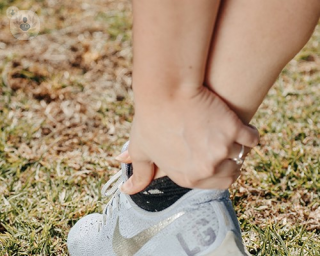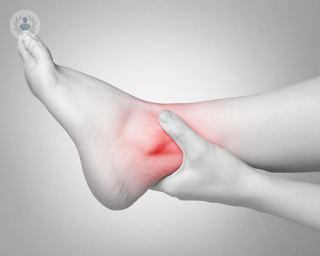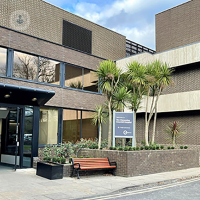What is the ankle?
The ankle is the joint that connects the foot to the leg and is important for being able to walk, run, or jump. It can be affected by a variety of injuries and conditions that can affect movement. The ankle is made up of three bones:
- Tibia (shin bone)
- Talus (sits above the heel bone)
- Fibula (runs next to the tibia)
In addition, the bony protrusions on your ankle are named as follows:
- Lateral malleolus – on the outside of the ankle at the base of the fibula.
- Posterior malleolus – at the back of the ankle at the base of the tibia.
- Medial malleolus – on the inside of the ankle, forming part of the tibia’s base.

Ankle function
The ankle can be described as a hinge-type joint with movement being allowed in one direction – both up and down. Other direction movements are allowed by other joints in the foot.
Pathologies of the ankle
- Sprained ankle – usually caused by an accidental twisting or turning motion to the ankle, damage to one of the ankle ligaments results.
- Breaks and fractures – result when any three of the ankle bones is fractured or broken. Tibia and fibula breaks and fractures are most common.
- Achilles tendinopathy (tendinitis and tendinosis) – inflammation and/or thickening of the Achilles tendon can cause pain, restricted movement and stiffness.
- Arthritis of the ankle – caused by gradual wear and tear
- Tarsal tunnel syndrome – caused by compression of the posterior tibial nerve, resulting in pain, the feeling of burning and pins and needles.
Treatments for ankle problems:
Many ankle injuries can benefit from the RICE method; Rest, Ice, Compression and Elevation, as well as pain medication. Other ankle injuries, such as breaks or fractures will require immobilisation in either an ankle cast or boot. More serious ankle problems may require surgery.
Which specialist treats ankle problems?
Orthopaedic surgeons may specialise in treating conditions of the foot and ankle.
11-13-2012 08-10-2023Ankle
Mr Jasdeep Giddie - Orthopaedic surgery
Created on: 11-13-2012
Updated on: 08-10-2023
Edited by: Sophie Kennedy
What is the ankle?
The ankle is the joint that connects the foot to the leg and is important for being able to walk, run, or jump. It can be affected by a variety of injuries and conditions that can affect movement. The ankle is made up of three bones:
- Tibia (shin bone)
- Talus (sits above the heel bone)
- Fibula (runs next to the tibia)
In addition, the bony protrusions on your ankle are named as follows:
- Lateral malleolus – on the outside of the ankle at the base of the fibula.
- Posterior malleolus – at the back of the ankle at the base of the tibia.
- Medial malleolus – on the inside of the ankle, forming part of the tibia’s base.

Ankle function
The ankle can be described as a hinge-type joint with movement being allowed in one direction – both up and down. Other direction movements are allowed by other joints in the foot.
Pathologies of the ankle
- Sprained ankle – usually caused by an accidental twisting or turning motion to the ankle, damage to one of the ankle ligaments results.
- Breaks and fractures – result when any three of the ankle bones is fractured or broken. Tibia and fibula breaks and fractures are most common.
- Achilles tendinopathy (tendinitis and tendinosis) – inflammation and/or thickening of the Achilles tendon can cause pain, restricted movement and stiffness.
- Arthritis of the ankle – caused by gradual wear and tear
- Tarsal tunnel syndrome – caused by compression of the posterior tibial nerve, resulting in pain, the feeling of burning and pins and needles.
Treatments for ankle problems:
Many ankle injuries can benefit from the RICE method; Rest, Ice, Compression and Elevation, as well as pain medication. Other ankle injuries, such as breaks or fractures will require immobilisation in either an ankle cast or boot. More serious ankle problems may require surgery.
Which specialist treats ankle problems?
Orthopaedic surgeons may specialise in treating conditions of the foot and ankle.


What to expect from ankle joint replacement surgery and recovery
By Mr Hisham Shalaby
2024-12-14
Revered consultant orthopaedic surgeon Mr Hisham Shalaby gives an informative guide to ankle joint replacement surgery for patients, including how the surgery is performed and what is involved in recovery. See more


Ankle ligament tears: all you need to know
By Mr Shelain Patel
2024-12-14
Ankle ligament tears are injuries where the ligaments, which connect and stabilise bones in the ankle, are partially or completely torn, often due to excessive twisting or rolling of the ankle. Leading consultant orthopaedic foot and ankle surgeon Mr Shelain Patel explains how they occur, common symptoms and treatment options. See more


Tips on foot care: ankle sprain and bunions
By Mr Paul Hamilton
2024-12-14
Landed awkwardly on your feet after a fall? If you're experiencing a swollen ankle, chances are you may have sprained it! Read more from our expert orthopaedic surgeon Mr Paul Hamilton on what you can do to ensure that the ankle heals as fast as possible. See more


How long does a child’s sprained ankle take to heal?
By Mr Darius Rad
2024-12-14
Have you recently noticed that your child has been struggling to bear their full leg weight on the ground? If so, they may have suffered an ankle sprain, and might require medical attention. Here, esteemed paediatric orthopaedic surgeon, Mr Darius Rad, provides with an all-we-need-to-know guide on ankle sprains in children. See more
Experts in Ankle
-
Mr Billy Jowett
Orthopaedic surgeryExpert in:
- Bunion (hallux valgus)
- Arthritis
- Ankle
- Flat feet
- Achilles tendon
- Ankle arthroscopy
-
Mr Jordi Sanchez-Ballester
Orthopaedic surgeryExpert in:
- Ankle
- Foot
- Knee arthroscopy
- Arthroplasty
- Knee surgery
- Osteoarthritis
-
Mr Barry Rose
Orthopaedic surgeryExpert in:
- Ankle
- Bunion (hallux valgus)
- Foot
- Sports injuries
- Achilles tendon
- Plantar fasciitis
-
Mr Togay Koç
Orthopaedic surgeryExpert in:
- Bunion (hallux valgus)
- Ankle
- Heel spur
- Foot and ankle
- Toe pain
- Flat feet
-
Mr Haroon Majeed
Orthopaedic surgeryExpert in:
- Ankle tendonitis
- Ankle
- Achilles tendon
- Foot fracture
- Inflammatory arthritis
- Plantar fasciitis
- See all

The Clementine Churchill Hospital - part of Circle Health Group
The Clementine Churchill Hospital - part of Circle Health Group
Sudbury Hill, Harrow HA1 3RX
No existe teléfono en el centro.
By using the telephone number provided by TOP DOCTORS, you automatically agree to let us use your phone number for statistical and commercial purposes. For further information, read our Privacy Policy
Top Doctors

The Wilmslow Hospital - part of HCA Healthcare
The Wilmslow Hospital - part of HCA Healthcare
52-54 Alderley Road, Wilmslow, Cheshire, SK9 1NY
No existe teléfono en el centro.
By using the telephone number provided by TOP DOCTORS, you automatically agree to let us use your phone number for statistical and commercial purposes. For further information, read our Privacy Policy
Top Doctors

Sheffield Orthopaedics Ltd
Sheffield Orthopaedics Ltd
Claremont Hospital, 401 Sandygate Rd, Sheffield
No existe teléfono en el centro.
By using the telephone number provided by TOP DOCTORS, you automatically agree to let us use your phone number for statistical and commercial purposes. For further information, read our Privacy Policy
Top Doctors
-
The Clementine Churchill Hospital - part of Circle Health Group
Sudbury Hill, Harrow HA1 3RX, West LondonExpert in:
- Abdominal ultrasound
- Abdominoplasty
- Acne
- Allergies bronchopulmonary
- Allergies nose and ears
- Allergy Dermatitis
-
The Wilmslow Hospital - part of HCA Healthcare
52-54 Alderley Road, Wilmslow, Cheshire, SK9 1NY, WilmslowExpert in:
- Breast Cancer
- Men's health check
- Orthopaedic surgery
- Obstetrics and Gynaecology
- Women’s health
- Sports Medicine
-
Sheffield Orthopaedics Ltd
Claremont Hospital, 401 Sandygate Rd, Sheffield, SheffieldExpert in:
- Hip
- Orthopaedic surgery
- Orthopaedic spinal surgery
- Shoulder and elbow
- Joint replacement
- See all
- Most viewed diseases, medical tests, and treatments
- Ulnar nerve entrapment
- Peripheral nerve block
- Peripheral neuropathy
- Joint pain
- Lumbar herniated disc
- Spinal surgery
- Minimal access surgery (keyhole surgery)
- Shoulder pain
- Osteoporosis
- Botulinum toxin (Botox™)








